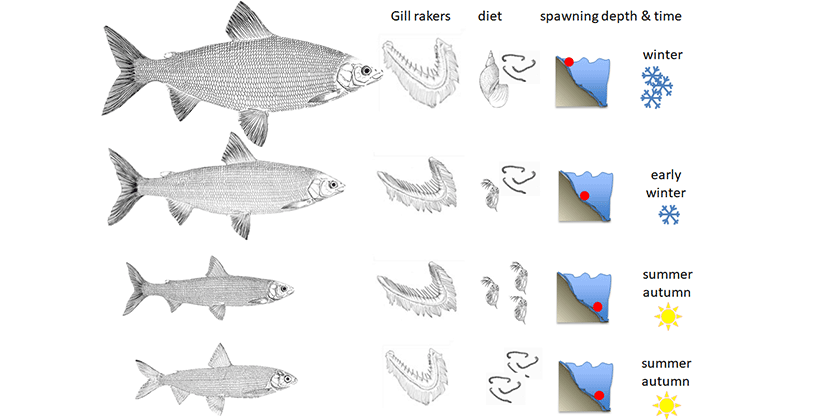Department Fish Ecology and Evolution
Biodiversity assembly in blue and green ecosystems: speciation versus immigration
This project contributes to the Blue Green Biodiversity Research Initiative — an Eawag-WSL collaboration focusing on Biodiversity at the interface of aquatic and terrestrial ecosystems.
Regional biodiversity assembles through ecological (e.g. immigration, species sorting) and evolutionary (e.g. speciation, adaptive radiation) processes. The relative importance of these vary across taxa and environments, and this variation shapes the structure of species assemblages, including species richness, relatedness, and niche occupation. Where immigration is the main source of diversity, richness scales linearly with area size, and the slope is shallow. Where speciation is the main source of diversity, the species area relationship is much steeper because rates of speciation are more strongly dependent on area than immigration rates are (Fig 1).

In systems where both immigration and speciation are important, the species area relationship tends to have a breakpoint around a critical area size where the shallow ecological slope changes to the steep evolutionary slope (Fig 2).

Speciation is particularly important where large areas are strongly isolated, such that abundant underutilized niches can be filled by evolution of new species faster than by colonization from outside. Species in such assemblages tend to be more closely related but ecologically often more complementary than species in immigration-assemblages. Because both types of assemblages respond differently to the same environmental change and because regionally evolved endemic biota is especially vulnerable to change, documenting the importance of immigration and speciation and understanding its variation in space and taxa is of fundamental relevance to conservation.
The Alpine bioregion of Europe holds some of the largest European endemic radiations in terrestrial and freshwater ecosystems involving flowering plants, fish, and invertebrates. At the same time, the Alpine region is also known for high rates of contemporary extinctions, invasions and biotic homogenization. Our objective is to examine and explain variation in the relative importance of speciation and immigration across blue and green ecosystems and to identify taxon- and ecosystem-specific breakpoints in the species area relationships where speciation becomes important (Fig 2). We focus on four taxonomical groups, representative for Alpine biodiversity: flowering plants, butterflies, fish and amphipods. We predict that speciation becomes important in relatively large ecosystems and in organisms that are ecologically versatile and evolvable but that experience dispersal limitation between similar ecosystems. Our project is of considerable applied relevance in the context of the “ecological infrastructure” and the Swiss Biodiversity Strategy promoted by the Swiss Federal Office for the Environment. Both aim to not only conserve biodiversity as is, but also to maintain the underlying processes that generate it.
Contact
 | Prof. Dr. Ole Seehausen Tel. +41 58 765 2121 Send mail |
 | Prof. Dr. Niklaus Zimmermann |
 | Dr. Luiz Jardim de Queiroz Tel. +41 58 765 2282 Send mail |


